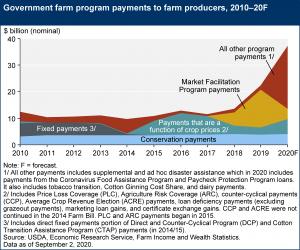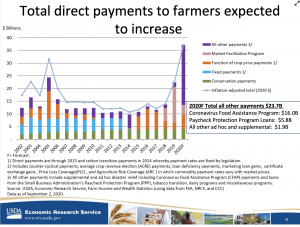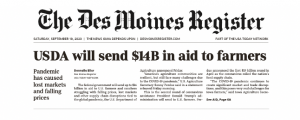Bloomberg's Mike Dorning reported on Wednesday that, "The Biden administration announced $12 billion in new farm aid, and said it will seek to expand Covid assistance to producers that weren’t…
New Round of Farm Aid for COVID Losses Announced, and Causes Snag in Congressional Spending Bill
Andrew Restuccia and Jesse Newman reported in Friday’s Wall Street Journal that, “President Trump unveiled $13 billion in new aid to farmers facing economic harm from the coronavirus pandemic as he aimed to boost support among rural voters at a campaign rally.
‘I’m proud to announce that I’m doing even more to support Wisconsin farmers,’ said Mr. Trump, speaking outside an airport hangar with Air Force One parked behind him, as he announced the agriculture aid.
The Journal writers explained that, “The newly announced aid would be the second tranche of money issued as part of the Trump administration’s Coronavirus Food Assistance Program. In April, the administration unveiled $19 billion in relief for the agriculture sector, including $16 billion in direct payments to farmers and ranchers and $3 billion in mass purchases of dairy, meat and produce. The funds came from coronavirus-relief legislation passed by Congress earlier this year as well as from the Department of Agriculture’s Commodity Credit Corp., a Depression-era program designed to stabilize farm incomes.
.@realDonaldTrump announced CFAP 2.0 relief for farmers & ranchers using the $14B in CCC funding we secured in the #CARESAct. Appreciate his administration’s ongoing support for our ag producers as they face challenges from weather, markets + COVID-19. https://t.co/XC9twuCpM4
— Senator John Hoeven (@SenJohnHoeven) September 18, 2020
“This time, the USDA said up to an additional $14 billion dollars would be available to farmers and ranchers facing continuing market disruptions and costs from the pandemic, including producers of row crops, livestock, specialty crops, dairy, aquaculture and other commodities. Farmers can apply for the aid at USDA’s county offices between Sept. 21 and Dec. 11 of this year. It couldn’t be determined why there was a discrepancy between the amount announced by Mr. Trump and the sum given by the USDA.
“The second round of direct payments likely supplements an already historic cash infusion into the nation’s Farm Belt. Projections released by USDA earlier this month showed government payments are set to surge 66% this year, to an annual record $37.2 billion.

“Even before taking the new tranche into account, those payments would push U.S. net farm income 23% higher to $102.7 billion, the highest since 2013, according to the USDA. They would comprise 36% of that total income, the highest share in nearly two decades.”

DTN writer Chris Clayton pointed out on Friday that, “CFAP 2 will have three different categories of payments to farmers based on price triggers, flat-rate crops and overall commodity sales.
#CFAP 2.0 effective payment rate for crops. This will be multiplied by acreage and the APH yield @FarmBureau pic.twitter.com/vFfpKasJES
— John Newton (@New10_AgEcon) September 18, 2020
“Under the price-trigger category are mainly major commodity crops that meet a 5% price decline over a specific period of time. This will include the broad range of commodities such as barley, corn, sorghum, soybeans, sunflowers, upland cotton and all classes of wheat.”
Wheat growers are resilient, but many still face challenges due the pandemic. COVID-19 has weakened market positions across all commodities throughout the U.S.- especially wheat.
— Frank Lucas (@RepFrankLucas) September 18, 2020
Thank you @SecretarySonny for addressing the needs of Oklahoma's hard red winter wheat growers.
Mr. Clayton pointed out that, “Payments will be made based on 2020 planted acres for the crop — excluding prevented planting and experimental acres.”
The DTN article added that, “USDA again has multiple determinations on how payments will be made with some complicated formulas steps thrown in. Payments will be the greater of:
“– Eligible acres multiplied by $15 per acre, or;
“– The eligible acres multiplied by a nationwide crop marketing percentage, multiplied by a crop-specific payment rate, and then by the producer’s weighted 2020 Actual Production History approved yield. If APH is not available, then the calculation will use 85% of the 2019 Agricultural Risk Coverage-County Option (ARC-CO) benchmark yield for that crop.”
Donnelle Eller reported on the front page of Saturday’s Des Moines Register that, “The USDA said the money for the second ag package would come from the Coronavirus Aid, Relief, and Economic Security Act — or CARES — and the Commodity Credit Corporation, an independent agency with authority to borrow $30 billion that’s being tapped to provide aid to farmers hit by coronavirus and trade disruptions.

“The coronavirus assistance comes on top of $28 billion the Trump administration provided in 2018 and 2019 to offset losses because of U.S. trade wars with China, Mexico, Canada and other nations, some of which continue.
“Congressional leaders are looking at a continuing resolution that would replenish the credit corporation’s funds.”
More specifically regarding the continuing resolution issue, Kristina Peterson reported in Saturday’s Wall Street Journal that, “A spending bill that Congress needs to pass to avoid a partial government shutdown next month hit last-minute snags Friday, as lawmakers and President Trump sparred over aid for farmers and election security.
“Lawmakers had hoped to unveil Friday a short-term spending bill to keep the government running after its current funding expires on Oct. 1. But fights over what to include in the legislation—potentially the only major bill to get signed into law before the election—delayed finalizing what is expected to be a bipartisan agreement that could pass in both the House and Senate next week.
“One debate emerged over the White House’s request to include $21 billion for the Agriculture Department’s Commodity Credit Corp., or CCC, a Depression-era program designed to stabilize farm incomes and which permits borrowing of as much as $30 billion from the Treasury to finance its activities. Democrats said they had concerns over replenishing a program if that meant giving President Trump a blank check to use for political purposes after he announced more aid for farmers at a campaign rally in Wisconsin Thursday night.”
The Journal article stated that, “The CCC program helped finance the first round of coronavirus-related aid to farmers, although Congress included some funding to reimburse it in previous relief legislation passed in March. But aides said its resources were already being depleted even before Mr. Trump announced a second round of $13 billion in farm aid at Thursday night’s rally.
“Funding that second round could impede the program’s ability to send out noncontroversial commodity support and conservation programs established by the farm bill, aides said. Once early October payments have been sent, the CCC program could be exhausted by November, the Farm Bureau estimated this week.”





